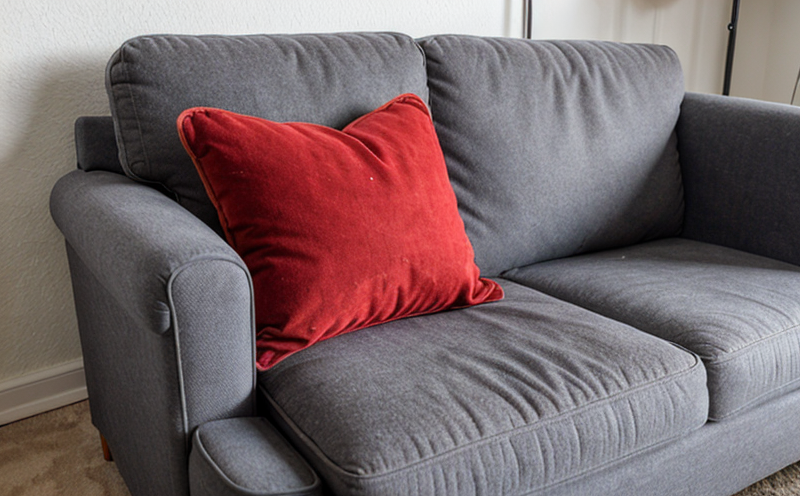BS EN 1021-1 Ignitability Testing of Upholstered Cushions Smouldering Cigarette
The BS EN 1021-1 test is a crucial step in ensuring the safety and compliance of upholstered furniture products. This standard evaluates the ignitability of cushions when exposed to smouldering cigarettes, simulating real-life scenarios where materials may come into contact with hot objects such as lit cigarettes or candles.
This testing procedure assesses the performance of both the fabric covering and the foam cushion itself under the influence of a smouldering cigarette. The test is designed to mimic the conditions that might be encountered in residential settings, thereby providing insight into the potential for ignition and subsequent fire spread.
The standard specifies detailed procedures for preparing specimens, conducting the test, and evaluating results. Specimens are typically cut from the actual cushions of upholstered furniture products. The test involves placing a smouldering cigarette at a specified point on the specimen and observing its behavior over time. Key parameters include the duration until ignition occurs and whether the fire spreads beyond the initial contact area.
The BS EN 1021-1 standard is part of a broader suite of furniture safety standards that aim to protect consumers from potential hazards associated with poorly designed or constructed products. Compliance with these standards not only ensures product safety but also helps manufacturers avoid costly recalls and legal issues.
For quality managers, compliance officers, R&D engineers, and procurement professionals involved in the development and production of upholstered furniture, understanding and adhering to the BS EN 1021-1 standard is essential. It provides a framework for ensuring that products meet stringent safety requirements, thereby enhancing consumer confidence and market reputation.
The test setup typically involves specialized equipment designed to simulate real-world conditions accurately. This includes controlled environments where temperature, humidity, and airflow can be precisely managed to replicate residential settings. The use of standardized smouldering cigarettes ensures consistency in testing across different laboratories.
Compliance with BS EN 1021-1 is mandatory for manufacturers aiming to sell their products within the European Union. Failure to comply can result in product recalls, legal action, and damage to brand reputation. Therefore, it is crucial for all stakeholders involved in the production chain to understand the requirements and ensure adherence.
The test results provide valuable insights into the fire resistance properties of materials used in upholstered cushions. This information is vital not only for compliance but also for continuous improvement in product design and manufacturing processes. By understanding which areas of a cushion are most susceptible to ignition, manufacturers can make informed decisions about material selection and process optimization.
The standard's emphasis on real-world scenarios makes it an indispensable tool for ensuring product safety. It helps identify potential hazards early in the development process, allowing for timely corrections and improvements. This proactive approach not only enhances product safety but also contributes to a safer living environment for consumers.
Applied Standards
| Standard Code | Description |
|---|---|
| BS EN 1021-1 | Ignitability of Upholstered Cushions - Part 1: Smouldering Cigarette Test |
| ISO 16951-1 | Textiles - Ignition Resistance of Textile Fabrics and Articles - Part 1: Smouldering Cigarette Test |
| ASTM D7342 | Standard Test Method for Determining the Flammability (Smoldering) of Upholstered Furniture |
| IEC 60335-1 | Household and Similar Electrical Appliances - Safety - Part 1: General Requirements for Safety |
Industry Applications
- Manufacturers of upholstered furniture, including sofas, armchairs, and recliners.
- Suppliers of textiles used in upholstery production.
- Designers of fire safety features for residential interiors.
- R&D teams focusing on improving material properties to enhance fire resistance.
The BS EN 1021-1 test is particularly relevant for these industries as it provides a standardized method for assessing the ignitability of cushions under specific conditions. This ensures that products meet regulatory requirements and enhances overall product safety.
Quality and Reliability Assurance
- Conducting regular audits to ensure compliance with the standard.
- Implementing rigorous quality control measures during production processes.
- Engaging in continuous improvement initiatives based on test results.
The BS EN 1021-1 test plays a crucial role in maintaining high standards of product safety and reliability. By adhering to this standard, manufacturers can demonstrate their commitment to quality and ensure that their products meet the highest safety benchmarks.





